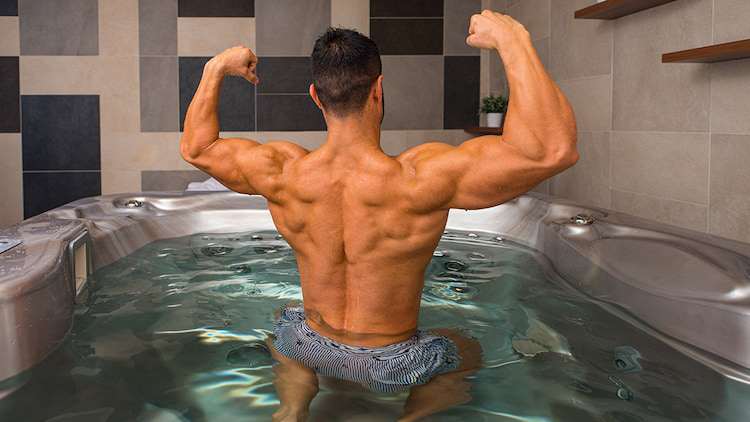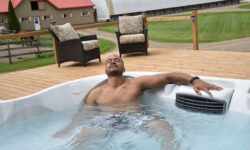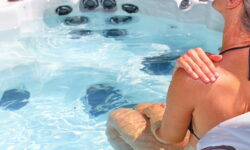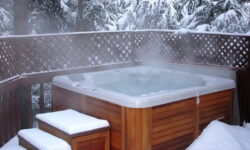Ever soaked in a hot tub and wondered why you’re sore after? You’re not alone. The heat can affect your body in ways you might not realize. It’s important to understand how hydration, circulation, and muscle reactions factor into this.
One common reason is the overexertion of muscles. The hot water in the tub can make your muscles relax and then suddenly contract, which can lead to muscle soreness later. Another reason could be dehydration. Hot tubs can cause you to sweat, leading to a loss of electrolytes and dehydration, which in turn can cause body aches.
Don’t worry, we’ve got some tips to help you avoid those post-hot tub aches. So, dive in, let’s understand why your body reacts the way it does and how to enjoy hot tubs without the after-pain.

Quick Navigation
Understanding the Effects of Heat on the Body
You’ve got to understand how heat affects your body to really get why you might be feeling sore after a soak in the hot tub.
Your body’s heat tolerance plays a significant role here. Just like a workout, soaking in hot water can cause your muscles to contract and expand, potentially leading to discomfort.
However, don’t worry, this is a normal reaction. Your body is simply adjusting to the temperature change. The increased heat stimulates blood flow, promoting healing and relaxation. Yet, too much heat can sometimes push your body past its comfort zone, leading to aches and pains.
Then there’s the matter of skin conditions. The heat and chemicals in a hot tub can potentially exacerbate certain skin conditions. If you have sensitive skin or a skin condition like psoriasis or eczema, you might find that hot tub use triggers flare-ups.
The Role of Hydration in Hot Tub Usage
While you’re enjoying a dip in the hot tub, two key factors to remember are hydration and temperature control, as both can significantly impact your body’s response to the heated water.
The importance of water intake can’t be overstated. The hot water and steam increase your body’s temperature, causing you to sweat. This is your body’s way of keeping cool, but it also means you’re losing fluid, potentially leading to dehydration.
Dehydration symptoms can sneak up on you during or after hot tub use. You might feel dizzy, have a headache, or experience muscle cramps – all signs that your body needs more water. In severe cases, you may feel nauseous or even start to vomit.
To prevent this, make sure to drink plenty of water before, during, and after your soak. Don’t wait until you’re thirsty. Thirst is a late sign of dehydration, and you want to stay ahead of it. Try to avoid alcohol as it can dehydrate you further.
Impact of Hot Tubs on Blood Circulation
You might not realize it, but when you’re soaking in a hot tub, your body’s blood circulation is significantly affected. The warm water promotes vasodilation, a process where your blood vessels expand. This has several benefits:
- Improved Blood Circulation: The expansion of blood vessels allows for better blood flow. This means more oxygen and nutrients can reach your muscles and organs, which can help to alleviate aches and pains.
- Increased Body Temperature: The heat from the hot tub raises your body temperature, which can also contribute to vasodilation benefits. It’s similar to what happens when you exercise.
- Sweating: As your body heats up, you’ll start to sweat. This is your body’s natural way of cooling down, but it also helps to eliminate toxins.
However, there’s a flip side. Overdoing hot tub soaks can lead to overheating and dehydration. This can put a strain on your heart and cause your blood pressure to drop, leading to dizziness, nausea or even fainting.
Muscular Reactions to Hot Tub Temperatures
In the heat of a hot tub, your muscles experience a range of reactions that can sometimes leave you feeling sore afterward.
This is due to something called thermal stress, a state your body enters when exposed to extreme temperatures.

Essentially, your muscles are working hard to maintain your body’s internal temperature, leading to a kind of muscle workout. This can result in muscle soreness or aching after you’ve stepped out of the tub.
But don’t worry, your body is quite capable of adapting to these conditions through a process known as heat acclimatization. Over time, regular hot tub use can help your body better manage the thermal stress, and get accustomed to the heat. This can potentially reduce muscle aches in the long run.
Tips to Prevent Aches After Using Hot Tubs
So, you’re looking for a solution to those annoying body aches after using a hot tub, and there are several preventative measures you can take. It’s important to adopt a correct posture, maintain your tub properly, and manage your time wisely when soaking.
Correct Posture
Remember to sit up straight. Slouching or lounging for long periods can strain your muscles causing discomfort later on. Try using a hot tub seat or cushion to support your posture. You’ll feel more comfortable and it’ll help prevent those aches.
Tub Maintenance
Clean your hot tub regularly. Unhygienic tubs can lead to skin irritations and infections, adding to your discomfort. Check the water’s pH level. If it’s too high or too low, it can cause skin and eye irritation, and even muscle aches.
Time Management
Limit your time in the hot tub. Staying in for too long can cause dehydration, a common cause of muscle aches. Hydrate before and after using the tub. This helps replace the water your body loses through sweating.
With these tips, you’ll be able to enjoy your hot tub sessions without the dread of aching muscles.
Frequently Asked Questions
Yes, prolonged hot tub use can lead to skin conditions. You’re particularly at risk for hot tub rash and dry skin concerns. It’s important to limit your soak time and moisturize afterward.
Yes, certain medical conditions could worsen with hot tub use. For instance, respiratory risks increase if you’ve lung issues. Also, if you’ve blood pressure concerns, hot tub use could potentially exacerbate them.
Yes, chlorine in hot tubs can exacerbate body aches. If you’ve chlorine allergies, it can cause respiratory effects and skin irritation, which may contribute to your discomfort and intensify existing aches.
Yes, limiting hot tub sessions is key. Aim for 15-30 minutes max. Remember, maintaining hydration and temperature regulation during your soak is vital. Overdoing it can lead to body aches.
Hot tub usage can actually enhance your sleep patterns. The warm water helps relax your body, facilitating sleep quality improvement. It’s also beneficial for jet lag recovery, resetting your internal clock effectively.
Conclusion
So, you’ve learned how heat affects your body, the importance of hydration, how hot tubs impact blood circulation, and why your muscles may react to hot tub temperatures.
To avoid those post-hot tub aches, remember to stay hydrated, limit your soak time, and pay attention to your body’s signals. Understanding these factors can help you enjoy your hot tub time without the discomfort afterwards. Happy soaking!





![Is Hot Tub Good for Cold? [Potential Risks & Precautions] Is Hot Tub Good for Cold](https://hottubtales.com/wp-content/uploads/2023/10/Is-Hot-Tub-Good-for-Cold.jpg)
